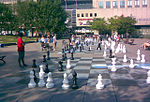Saint-Jacques Cathedral (Montreal)
19th-century Roman Catholic church buildings in CanadaBurned buildings and structures in CanadaCathedrals in MontrealDemolished buildings and structures in MontrealFormer cathedrals in Canada ... and 7 more
John Ostell buildingsRoman Catholic cathedrals in QuebecRoman Catholic churches completed in 1825Roman Catholic churches in MontrealUniversity and college buildings in CanadaUniversité du Québec à MontréalVille-Marie, Montreal

Saint-Jacques Cathedral (Cathédrale Saint-Jacques) was the Roman Catholic cathedral in Montreal from 1825 to 1852, named for St. James the Greater. From 1825 to 1836, it was the seat of the auxiliary bishop of Quebec in Montreal. With the creation of the Roman Catholic Diocese of Montreal in 1836, it became the cathedral of the new diocese.
Excerpt from the Wikipedia article Saint-Jacques Cathedral (Montreal) (License: CC BY-SA 3.0, Authors, Images).Saint-Jacques Cathedral (Montreal)
Rue Sainte-Catherine Est, Montreal Ville-Marie
Geographical coordinates (GPS) Address Nearby Places Show on map
Geographical coordinates (GPS)
| Latitude | Longitude |
|---|---|
| N 45.5142 ° | E -73.561 ° |
Address
Pavillon Judith-Jasmin
Rue Sainte-Catherine Est 405
H2L 2C4 Montreal, Ville-Marie
Quebec, Canada
Open on Google Maps









